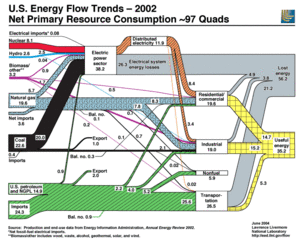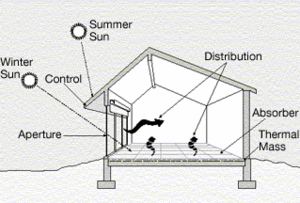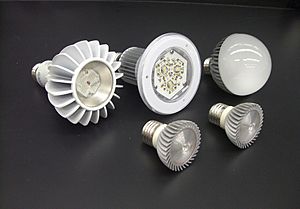Energy conservation facts for kids
Energy conservation means using less energy for different things. When we save energy, it can help us save money, protect the environment, and even make our countries and homes more secure. It also makes us more comfortable.
People and groups who use energy directly, like families and businesses, might want to save energy to cut down on costs. This also helps make our world more sustainable for the future. Companies might save energy to be more efficient and earn more profit.
On a bigger scale, saving energy is a very important part of how countries plan their energy use. It helps reduce how much energy each person uses. This can stop energy prices from going up too much and means we don't need to build as many new power plants. It also helps us choose better ways to produce energy.
By using less energy, we also create fewer emissions (like gases from burning fuel). This is a big way to help stop climate change. Saving energy also makes it easier to switch from non-renewable energy sources (like oil and gas) to renewable energy (like solar and wind). Often, saving energy is the cheapest and best way to deal with energy shortages.
Contents
Why Countries Use Energy Taxes
Some countries use special fees called energy or carbon taxes. These taxes encourage people and businesses to use less energy. For example, a carbon tax might make people choose cleaner energy sources like nuclear power. Taxes on all energy use can reduce how much energy is used overall.
In California, USA, there's a special energy tax system. Everyone gets a basic amount of energy at a low tax rate. But if you use more than that basic amount, the tax goes up a lot. This system helps protect families who don't use much energy, while making big energy users pay more.
Saving Energy in Buildings
One great way to save energy in buildings is to do an energy audit. This is like an inspection of a building to see how energy is used and where it might be wasted. Experts can find ways to use less energy without making the building less comfortable or useful. There are even smartphone apps now that let homeowners do their own energy audits!
New building technologies and smart meters can show people how much energy they are using in their homes or workplaces. Seeing this information in real-time can help people make choices to save energy.
In passive solar building design, buildings are made to collect, store, and spread solar energy as heat in winter. They also block solar heat in summer. This is called "passive" because it doesn't use machines or electricity, unlike active solar heating systems.
The main idea behind passive solar design is to use the local climate to your advantage. This means thinking about where windows are placed, what kind of glass they have, how much insulation is used, and how much thermal mass (materials that store heat) is in the building. Passive solar design is easiest for new buildings, but older buildings can also be updated.
Saving Energy in Transportation
In many places, like the United States, towns and cities were built when it was easy to get fossil fuels. This led to people needing cars for almost everything. Changing city plans to allow more buildings closer together and making it easier to walk or bike can greatly reduce the energy used for travel.
Also, many people now work in jobs where they can do their tasks from home. This is called telecommuting. When people work from home, they don't have to drive to work every day, which saves a lot of energy.
Smart Choices for Products
Sometimes, people don't know how much money they can save by buying energy-efficient products. A good example is light bulbs. Many people buy cheap old-fashioned incandescent light bulbs. But these bulbs use a lot of energy and don't last long. Newer compact fluorescent (CFL) and LED bulbs cost more at first, but they use much less energy and last a very long time. This saves a lot of money in the long run. The price of LED bulbs has also been going down. The U.S. Department of Energy thinks that if everyone used LED lighting, the United States could save about $265 billion in energy costs over 20 years!
It can be hard for shoppers to figure out which products are truly energy-efficient. Some governments and groups are trying to make this easier with ecolabels. These labels show how energy-efficient a product is, so you can easily compare them when you shop.
In warm places where people use air conditioning, any device that gives off heat will make the air conditioner work harder. Things like stoves, dishwashers, clothes dryers, hot water heaters, and incandescent lights all add heat to a home. Using low-power or insulated versions of these devices means less heat for the air conditioning to remove.
In cold places, heating air and water uses a lot of energy. Investing in newer technologies for your home can save a lot of energy. Heat pumps are much more efficient than electric heaters for warming air or water. There are also many efficient clothes dryers, and using a classic clothes line uses no energy at all! New homes can also use heat exchangers to capture heat from used water or air from bathrooms and kitchens.
In both very hot and very cold climates, how well a home is sealed and insulated makes a huge difference in its energy efficiency. Insulation helps stop heat from moving into or out of the home. Adding insulation to an old home can take a lot of work.
How Countries Save Energy
Asia
Many countries in Asia are working to cut down on energy use. Governments offer help like money, loans, and tax breaks to encourage energy-saving projects. They also have programs to give people information and labels for buildings, appliances, and transportation. For example, Japan has a "Cool Biz campaign" that encourages people to set air conditioners to 28 degrees Celsius and dress casually in summer.
European Union
The European Union (EU) promised to cut its yearly energy use by 20% by the year 2020. They have an "Energy Efficiency Action Plan" to help reach this goal. One rule, called the Boiler Efficiency Directive, sets minimum efficiency levels for boilers that use liquid or gas fuels.
India
In India, the Petroleum Conservation Research Association (PCRA) was started in 1977. It works to promote energy efficiency and conservation everywhere. They have done big campaigns on TV, radio, and in newspapers. These campaigns have helped people save a lot of fossil fuels and reduce pollution. The Bureau of Energy Efficiency is another Indian group that promotes energy efficiency.
Japan
Since the 1973 oil crisis, saving energy has been very important in Japan. Japan imports all its oil, so it is developing its own sustainable energy sources. The Energy Conservation Center in Japan promotes energy efficiency in all parts of life. They have projects like the Top Runner Program. In this program, new appliances are tested for how efficient they are, and the most efficient ones become the standard.
United States
The United States is one of the biggest energy users in the world. The U.S. Department of Energy divides national energy use into four main areas: transportation, homes, businesses, and industries.
About half of the energy used in the U.S. is for transportation and homes, which is mostly controlled by individual people. Businesses and factories decide how much energy they use. The government's energy plans have a big effect on energy use in all these areas.
Other pages
See also
 In Spanish: Conservación energética para niños
In Spanish: Conservación energética para niños





